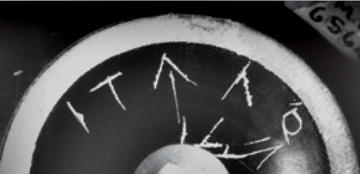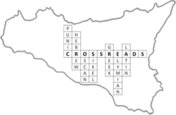Digital palaeography and the ‘Elymian’ and ‘Sikel’ inscriptions of Archaic Sicily
Systematic study of the palaeography of epigraphic documents is a highly desirable end in itself – such study has been rarely undertaken in the past, and is almost wholly lacking for the island of Sicily, despite the fact that letter forms are frequently employed, very subjectively, as a dating criterion. A comprehensive and consistent digital corpus, with high resolution imagery, offers a unique opportunity to put such study on a new footing. This already presents its own challenges with the relative lack of agreed standards in epigraphy for palaeographic description and a lack of established standards in the linked data world. Since the I.Sicily project is closely integrated with current community efforts to establish linked data standards in epigraphy, we hope to make a significant contribution in this area. From a practical point of view, we will be working with the King’s Digital Lab to develop modular tools from the Archetype framework, originally developed for the DigiPal project, in order to enable palaeographic annotations and visualisation linking the TEI EpiDoc texts with the IIIF images.
This methodology allows for the categorisation and comparison of detailed; structured descriptions of letter forms, punctuation and decoration, dividing the evidence by type of script, scribal hand, and by granular characteristics (e.g. a broken crossbar). Systematic comparison of letter components and features enables us to trace patterns of influence and development in writing systems in a consistent and coherent way, accompanied by well-documented categorisation of letter forms, image annotations for easy visualisation and linked open data (Stokes 2017). This method will be the basis for investigating other material in the Crossreads project and will allow us to present a comprehensive picture of palaeographic trends on the island, fitting into the recent larger framework of increased interest in epigraphic palaeography.
The Elymian and Sikel corpora are obvious starting points, as they are discrete, coherent and already present known palaeographic peculiarities (see for an overview of the languages Prag 2020 and About the arrow-shaped Alpha and Sikel identity). The Elymian material (c. 444 graffiti on ceramic fragments and coin legends found in the western part of Sicily, see Agostiniani, 2021; Mignosa, Prag forthcoming) is characterised by a marked linguistic and palaeographical coherence that makes it a perfect sample for applying the proposed research methodology. Most of the epigraphic documents on ceramic are highly fragmentary (see e.g. ISic020089, fig. 1) - with the exception of a single intact vase (ISic020283). They consist of graffiti incised after firing on black-figure Attic pottery, or on local pottery (in smaller numbers) dated between the end of the 6th and the beginning of the 5th century BCE and of coin legends dated between the beginning and the end of the 5th century BCE (on dating, see Marchesini, 2012; Agostiniani, 2021, 62-63 and 65-66). Most of the texts are in Elymian, while some may be in Greek.

Fig.1. Inscription on a fragment of foot of a black-glaze lekythos from Grotta Vanella, Segesta, 520-480 ca. BCE (ISic020089, stored at Museo A. Salinas inv.no. 54127)
In comparison, the Sikel corpus presents an epigraphic-linguistic specificity, endowed with linguistic varieties characterised by the absence, almost everywhere, of aspirated consonants and aspirations and by the use of a particular type of alpha (fig. 2), realised in two main variants, the first with a stroke attached to the apex and the second with a detached stroke, whose dissemination is found only in the Sikel area. In addition to linguistic variety, there is some heterogeneity of epigraphic usage, mainly determined by the influence of the nearest Greek town or towns with which these communities had more contact. Several micro-regions have been identified on the basis of epigraphic habits (Agostiniani, 1992, 130-132).

Fig. 2. Example of the arrow-shaped alpha (type2)
Due to the dissemination/distribution of the arrow-shaped alpha (so called alpha siculum, Ribezzo, 1913, 374) almost exclusively in the Sikel area, it has been hypothesised that the use of this particular type of alpha was linked to the Sikels' intention to mark their inscriptions in an identity-oriented way, according to a socio-anthropological model defined as 'antagonistic acculturation' (Cardona, 1981), which would lead a group/people to adopt customs deliberately in contrast to those of the dominant group. This hypothesis has remained the most plausible (and the most appealing) to account for the existence of the particular ductus of the letter. However, before concluding that there were identity reasons behind this epigraphic practice, we should ask ourselves whether this alpha was indeed so aberrant (or atypical) in the Greek epigraphy of the island as to be considered a Sikel marker through and through. As recently shown (Tribulato, Mignosa 2021) the arrow-shaped alpha, widespread in different areas of the island, may have been adopted by the workshops at Sikel centres that were in contact with the poleis where it was used and then reiterated in the Sikel centres as the 'preferred' type. Its dissemination would therefore depend on the communication and exchange routes of the area (ibid.: 310-315).
As this last example shows, the study of alphabetical variants has long been dominated by discussions which were unrelated to epigraphic practice in its historical and cultural context. While such discourses may be meaningful in some circumstances, the starting point for the study of the palaeography of epigraphic material should be to identify objective criteria on which to ground itself. Using our proposed methodology will allow us to trace the use of alphabets and variants across objects and regions in a consistent way. We can compare the use and distribution of palaeographic features which can, in turn, inform us about the interrelations between alphabets in a multilingual context. Whether the use of a specific allograph was deliberate as an identity-marker or a simple regional variation, the systematic annotation and the ability to link across the rest of Crossreads (linguistics, materials, geographic locations), will help us study this material in its full context (fig. 3).

Fig. 3. Comparison of different allographs of alpha from ISicily



